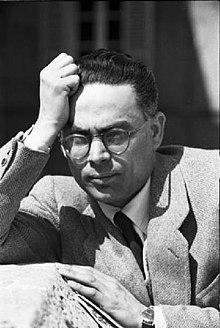fiction.wikisort.org - Writer
Leonardo Sinisgalli (1908–1981) was an Italian poet and art critic active from the 1930s to the 1970s.

Sinisgalli was born in Montemurro, Basilicata. His early education and careers led to him being called the "engineer poet".
In 1925, Sinisgalli moved to Rome where he studied engineering and mathematics. After completing his engineering degree in 1932, he moved to Milan where he worked as an architect and graphic artist. He was a close friend of the poet Giuseppe Ungaretti and painter Scipione. He worked at Milan for architecture and graphic design projects.
Sinisgalli's early collections such as Cuore (1927), 18 poesie (1936), Campi Elisi (1939) focused on themes from ancestral southern Italian myths. Later he explored a more relaxed style in I nuovi Campi Elisi (1947), La vigna vecchia (1952), L'età della luna (1962), Il passero e il lebbroso (1970), Mosche in bottiglia (1975) and Dimenticatoio (1978). He authored prose that analyzed the conflicts of existentialism and realism such as Fiori pari, fiori dispari (1945) and Belliboschi (1948). He also explored the scientific culture of the day in Furor mathematicus (1944) and Horror vacui (1945).
Sinisgalli founded and managed the magazine Civiltà delle Macchine (1953–1959), and was a member of the Scuola Romana. He also created two documentaries which consecutively won the Biennale di Venezia awards and edited radio broadcasting programs.
He died in Rome in 1981.
References
- Sinisgalli, Leonardo (November 1982). The Ellipse: Selected Poems of Leonardo Sinisgalli (Lockert Library of Poetry in Translation). Princeton University Press. ISBN 0-691-06529-2.
- Zuliani, Stefania (1997). Il demone della contraddizione: Sinisgalli critico d'arte (Scenari dell'arte). Guerini studio. ISBN 88-7802-781-2.
- Luigi Beneduci, Bestiario sinisgalliano. Studio sull'immaginario zoomorfo di Leonardo Sinisgalli, Aracne, Roma, 2011.
- Ferrarelli, Rina, editor and translator (1997). Leonardo Sinisgalli: I Saw The Muses: Selected Poems 1931-1942. Guernica, Toronto/New York/Lancaster. ISBN 1-55071-025-7.
External links
На других языках
- [en] Leonardo Sinisgalli
[fr] Leonardo Sinisgalli
Leonardo Sinisgalli, né le 9 mars 1908 à Montemurro et mort le 31 janvier 1981 à Rome, est un ingénieur et poète italien.[it] Leonardo Sinisgalli
Leonardo Rocco Antonio Maria[1] Sinisgalli (Montemurro, 9 marzo 1908 – Roma, 31 gennaio 1981) è stato un poeta, saggista e critico d'arte italiano. È noto come Il poeta ingegnere o Il poeta delle due muse, per il fatto che in tutte le sue opere ha sempre fatto convivere cultura umanistica e cultura scientifica[2]. Per la sua versatilità è stato definito "un Leonardo del Novecento"[3] in quanto è stato narratore, pubblicista, direttore artistico, direttore di riviste, documentarista, autore radiofonico, disegnatore.Другой контент может иметь иную лицензию. Перед использованием материалов сайта WikiSort.org внимательно изучите правила лицензирования конкретных элементов наполнения сайта.
WikiSort.org - проект по пересортировке и дополнению контента Википедии